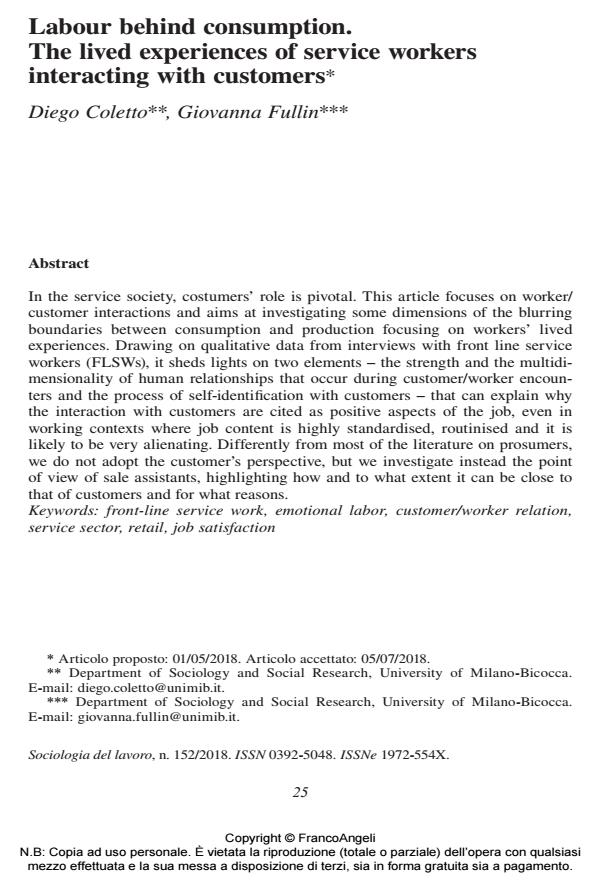Labour behind consumption. The lived experiences of service workers interacting with customers
Titolo Rivista SOCIOLOGIA DEL LAVORO
Autori/Curatori Diego Coletto, Giovanna Fullin
Anno di pubblicazione 2018 Fascicolo 2018/152
Lingua Inglese Numero pagine 18 P. 25-42 Dimensione file 111 KB
DOI 10.3280/SL2018-152002
Il DOI è il codice a barre della proprietà intellettuale: per saperne di più
clicca qui
Qui sotto puoi vedere in anteprima la prima pagina di questo articolo.
Se questo articolo ti interessa, lo puoi acquistare (e scaricare in formato pdf) seguendo le facili indicazioni per acquistare il download credit. Acquista Download Credits per scaricare questo Articolo in formato PDF

FrancoAngeli è membro della Publishers International Linking Association, Inc (PILA)associazione indipendente e non profit per facilitare (attraverso i servizi tecnologici implementati da CrossRef.org) l’accesso degli studiosi ai contenuti digitali nelle pubblicazioni professionali e scientifiche
In the service society, costumers’ role is pivotal. This article focuses on worker/ customer interactions and aims at investigating some dimensions of the blurring boundaries between consumption and production focusing on workers’ lived experiences. Drawing on qualitative data from interviews with front line service workers (FLSWs), it sheds lights on two elements - the strength and the multidi-mensionality of human relationships that occur during customer/worker encoun¬ters and the process of self-identification with customers - that can explain why the interaction with customers are cited as positive aspects of the job, even in working contexts where job content is highly standardised, routinised and it is likely to be very alienating. Differently from most of the literature on prosumers, we do not adopt the customer’s perspective, but we investigate instead the point of view of sale assistants, highlighting how and to what extent it can be close to that of customers and for what reasons.
Nella società di servizi, il ruolo dei clienti è fondamentale. Questo articolo si con-centra sull’interazione cliente/lavoratore e mira ad indagare alcune dimensioni del-la relazione fra consumo e produzione, concentrandosi sulle esperienze vissute dai lavoratori. Basandosi su dati qualitativi tratti da interviste con assistenti alla vendi-ta, l’articolo mette in luce due elementi: (1) la forza e la multidimensionalità delle relazioni umane che si realizzano durante la relazione cliente/lavoratore e (2) il processo di auto-identificazione con i clienti. Questo secondo elemento spiega per-ché l’interazione con il cliente è spesso citata come aspetto positivo del lavoro an-che in contesti lavorativi alienanti, in cui il contenuto del lavoro è piuttosto povero e altamente standardizzato ed in cui prevalgono mansioni routinarie. A differenza della maggior parte della letteratura sui prosumers, l’articolo non analizza la pro-spettiva del cliente ma si focalizza piuttosto sul punto di vista degli assistenti alla vendita, evidenziando come e in che misura la loro prospettiva si avvicina a quella dei clienti e per quali ragioni.
Parole chiave:Lavoro al servizio del cliente, lavoro emotivo, relazione clien-te/lavoratore, servizi, vendita al dettaglio, soddisfazione per il lavoro
Diego Coletto, Giovanna Fullin, Labour behind consumption. The lived experiences of service workers interacting with customers in "SOCIOLOGIA DEL LAVORO " 152/2018, pp 25-42, DOI: 10.3280/SL2018-152002